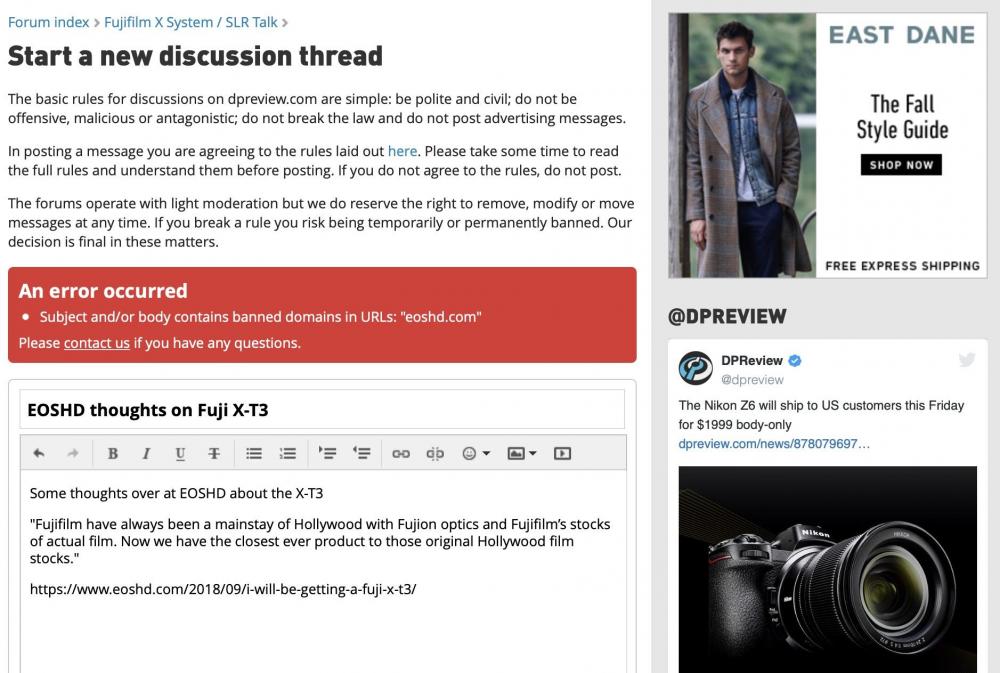-
Posts
15,610 -
Joined
-
Last visited
Content Type
Profiles
Forums
Articles
Everything posted by Andrew - EOSHD
-
It might be time we re-visited the poor old A9 since the price halved! Help yourself here - https://www.mpb.com/en-uk/search/?www-product-search=sony+a9&www-department=all It is still around £400 more than an A7 III but it has some interesting extras: Slight more natural edge to very fine detail in 4K Far less rolling shutter and possibly slightly better motion cadence 20fps RAW for 10 seconds to 240 shot buffer = might be creatively interesting for video Drive dial and AF mode selection lever Electronic shutter usable in artificial light without banding (1/160 second sync / readout speed vs 1/30 on A7 III I believe?) No viewfinder blank out 50% higher resolution screen (1440k vs 922k) and EVF (3.6m vs 2.3m) Slightly more tactile ergonomics and buttons Possible improvements in white balance and colour on A9 (unproven to my eyes unless I get hold of an A9) Of course we still lack S-LOG / picture profiles / HGL but if you're doing light grading, it is surprising how much you can colour correct Neutral. A7 III is also a bit cleaner in low light then REALLY pushed or shadows raised +6ev in RAW stills... As it hasn't got a hot RAM chip glued to the back of the sensor. Otherwise they are both very impressive at high ISOs. There is still a chance it could get a firmware update for at least HGL, then it makes it a no brainer to pay just £400 more for a used A9 than get the A7 III, in my opinion!
-
An interesting thought sir.
-
Some people are interested, some are not. Let the people who are interested in changing things to discuss it and get on with it.
-
Private companies love to pretend to uphold our constitutional rights (like freedom of speech) but when it comes to it, they are shown up. They have no legal obligation to protect free speech.
-
Meanwhile at DPReview: So much for free speech! And their feedback section has plenty of concerns about the amount of sponsored content they have been running lately https://***URL removed***/forums/5001 Which I criticised... Hence the ban on my links. Are we living in China or the west?
-
Indeed, but it's astonishing the lows a PR department can go to for clicks. So in a way not too surprising. Canon's legal department once tried to pull Canon Rumors down altogether, but as they have survived and become a regular source of clicks, Canon's PR department has got involved. You can envisage a point in the future where their legal department will be trying to sue someone at the same time their PR department is running a give-away with them. Satire has become the modus operandi of companies and politicians in 2018 Aside from your visits to EOSHD counting against you at Canon Rumors, imagine what other data they are holding about your browsing history. Like I say, I think people should query that with Craig directly - canonrumorsguy@gmail.com And request deletion of ALL tracking cookies immediately.
-
Yes that's the latest trick. It was always my intention to criticise clickbait until it vanishes off the internet, only to be replaced with a text file saying "Hello"! Now let's start on 43rumors!
-
Check this out https://www.newsshooter.com/2018/11/14/tilta-bmpcc-4k-cage-hands-on-interbee-2018/ An all-new preview hands-on. But most interestingly of all take a look at the price. Half cage is $99. That's a LOT cheaper than the other high-end cages I've seen so far. The other bits are very competitive too.
-
I asked Canon Rumors about the redirecting to EOSHD of his URLs. Apparently we disrupted his little tie-up with Canon's PR department, when I jokingly asked people to join the EOS R give-away so we could give it to Magic Lantern to play with. Their PR people cancelled it ? Or was I joking? I can't remember Anyway, he is trying to ban us from viewing the site now, by using a script on his server that detects if you have visited a Canon Rumors link on EOSHD, and redirecting that link back here. Along with a lot of fishy ad trackers on there which analyse your web browsing history and past purchases. If you don't like this email him. canonrumorsguy@gmail.com I am sure he will come to his senses eventually, and maybe even give one of his EOS Rs to Magic Lantern ? In the meantime if you want to link to a clickbait made-up Canon Rumors story from an EOSHD forum post, I'm not going to stop you, just use an URL shortener like Google's This should bypass their blocking. Try going to this Canon Rumors article via my shortened link for instance: https://goo.gl/Krp6W5
-

Nikon Z6 features 4K N-LOG, 10bit HDMI output and 120fps 1080p
Andrew - EOSHD replied to Andrew - EOSHD's topic in Cameras
Z6 in the YouTube title. Z7 on the titles. What to believe. Christ. -

Colour Differences on Youtube across browsers
Andrew - EOSHD replied to jgharding's topic in Cameras
Well we make art primarily for ourselves and get a lot of pleasure putting it out there, sharing it with other people. It's up to them whether they have a proper view from the crowd or not. It's a shame a lot of them don't but nothing we can do about it Tech companies on the other hand could start by getting their fucking act together -

Canon EOS R first impressions - INSANE split personality camera
Andrew - EOSHD replied to Andrew - EOSHD's topic in Cameras
Happening for you as well? https://www.canonrumors.com/page/2/ -
I just received my Kipon. I'll be reviewing it this week on the Nikon Z7. E-mount version is the same glass.
-

Canon EOS R first impressions - INSANE split personality camera
Andrew - EOSHD replied to Andrew - EOSHD's topic in Cameras
It's not just you. I could go through Google to that Canon Rumors news post about the Sony sensor and it would bounce me straight back to EOSHD. I have no ad cookies on this site or tracking cookies, it's just images and text, so what is going on at Canon Rumors to direct people here through what I assume is an error on their site? Deeply suspicious. -

Canon EOS R first impressions - INSANE split personality camera
Andrew - EOSHD replied to Andrew - EOSHD's topic in Cameras
Looks like they fixed the headline but... this page 2 link STILL points to EOSHD! What game is going on here? WTF?! -

Who wants to have a go at grading EOSHD Z-LOG?
Andrew - EOSHD replied to Andrew - EOSHD's topic in Cameras
Not like you to miss the point lol. A LOG profile is not just a dynamic range tool in the box, it is necessary for colour grading, colour matching, LUTs, and more. -

Canon EOS R first impressions - INSANE split personality camera
Andrew - EOSHD replied to Andrew - EOSHD's topic in Cameras
I own Canon Rumors now. It's all mine -
If only Sony knew how to do apps justice, they could have taken over with this sucker.
-
What was this Sony live view grading app we speak of? I must have missed that. Tethered?
-
Could be worse, it is not on fire like California is!! What's going on with the climate... It's bonkers.
-
It's the difference between Canon LOG and a flat profile. With the flat profile, I find Nikon start the black level quite low and so the shadows get more compression. H.264 doesn't prioritise that area. With Z-LOG I start the black level a lot higher like Canon LOG does and also the colour gamut is different. Also there are two Z-LOG profiles - Cinema and "L". In Cinema mode the camera uses the best Nikon colour science there is, the basis of which is the Standard profile. I was able to get absolutely superb results from this, with minimal grading effort. In L mode it uses a colour gamut similar to Sony S-LOG and that makes it more compatible with existing LUTs. Jacob - not sure what LUT you are using. You can't use the same LUT on Flat, Z-LOG Cinema and Z-LOG L as they all have different gamma curves and colour spaces. I'd be happy to see some of your tests but the original footage rather than the graded stuff. If you post graded stuff I don't know what you are doing to the file. Also it might be that the scene you shot of your girlfriend isn't challenging in terms of dynamic range so you won't see the advantage of Z-LOG over one of Nikon's built in profiles, especially in the blacks.
-
Yep ask for a replacement. It's not that flimsy on most cameras, just some of them. Mine has not fallen off yet, and no battery has got stuck... Mainly because, it has to be said, it's been raining EVERY EFFING DAY since I got my camera and still cannot go out and shoot properly with it!! Time to move to Spain?!
-
Use your better judgement. I am sick of being led out to some clickbait SHIT or discussing ad-infinity yet another shitty YOUTUBE video. This forum needs to get back on track. It's a turn off. When did you guys stop CREATING stuff and posting that instead?!






